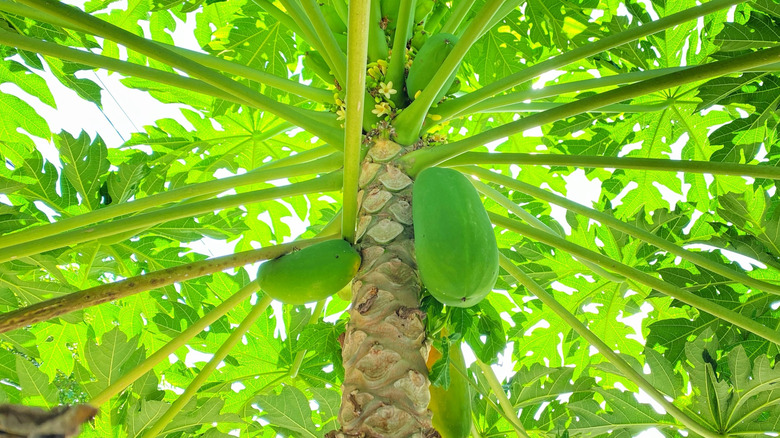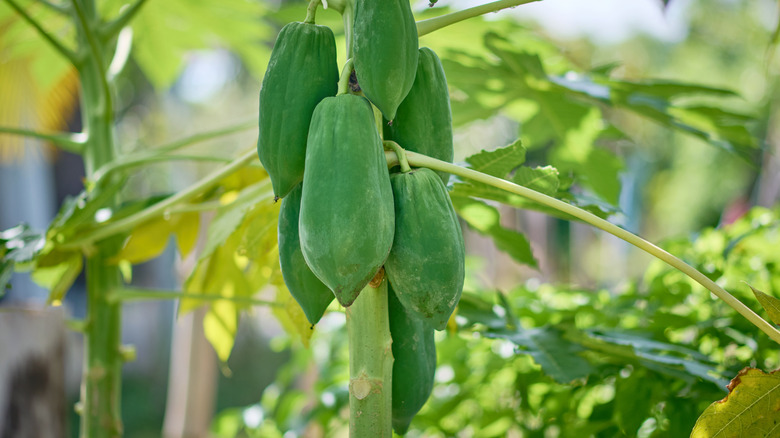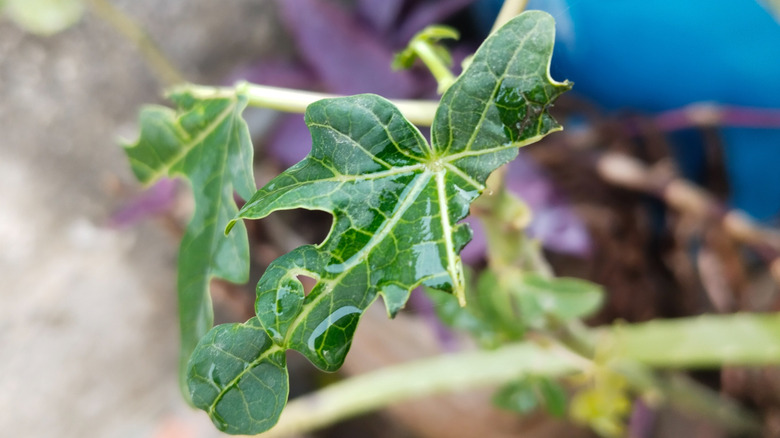Companion Plants To Grow Near Papaya Tree To Help It Thrive
When some gardeners think about how to successfully grow a papaya tree, their approach might be to drown the trees in pesticides and chemical fertilizers. Luckily, there's another way to help your papaya trees thrive that's both natural and low-cost — the magic of companion planting. The right companion plants feed papayas the nutrients they require to grow, which means more delicious fruits for you to enjoy. Papaya is considered a nutritionally heavy feeder, and it needs a lot of nitrogen to support its growth, leaf production, and fruiting.
Because of this, it makes sense to grow plants that fix nitrogen in the soil around papaya trees. Nitrogen fixation is a process by which certain microorganisms convert nitrogen in the air, which plants can't use, into a form that they can use. Growing plants with these capabilities will cover empty space in your yard while also giving your trees a boost of nutrients. On top of being heavy feeders, papayas are also pest magnets, but companion planting can help by attracting good bugs that will chase pests from your garden. Papaya trees are hardy to USDA zones 9 through 11, so it's important that whatever companion plants you choose can handle similarly warm climates.
Nitrogen-fixing companion plants to grow near papaya
Several plants can help add nitrogen to soil, from legumes like clover to stunning flowers that quietly enrich your garden's soil while they bloom. Clover fixes nitrogen while doubling as a living mulch, and its sprawling ground cover and root systems also help prevent soil erosion. This makes clover a fantastic choice if you are planning to grow papayas in erosion-prone areas like steep landscapes. However, some clover types can become weedy or even invasive, so plant with caution.
Clover is technically part of the legume family, but if you want to play it safer, you can plant other non-clover legumes like peas as companion plants to help nourish papayas. Besides their ability to fix nitrogen, legumes can also improve soil structure by adding organic matter to the soil, which will help your plants thrive. This soil structure benefit is especially true of deep-rooting legumes like alfalfa.
The nutritional abilities of companion plants are not just limited to bringing nitrogen. If your soil is lacking in potassium or phosphorus, you may want to try growing garden nasturtium. This resilient plant's flowers are packed with nutrients beyond just potassium and phosphorus, including magnesium and calcium. If you add a few nasturtium flowers to your compost and use it as mulch, your papayas can get an extra nutrient boost.
Pest-fighting companion plants to grow near papaya
What if you successfully boost papaya growth, only to see pests crashing the party? Papayas are susceptible to a range of pest problems, but luckily, there are companion plants that can help. Instead of growing plants meant to deter unwelcome insects, you can create insectary strips to attract pest-eating predators with plants like dill, cilantro, thyme, and yarrow. These all attract beneficial insects that will help chase away aphids, whiteflies, and other common papaya pests.
Another nuisance that affects papaya plants is nematodes. These microscopic, thread-like roundworms in the soil can cause immense damage to papaya roots, which can lead to wilting and an overall decrease in plant vigor. If you've been dealing with a nematode problem, try adding marigolds to the borders around papayas. These flowers release compounds called thiophenes that can repel nematodes. In general, beware of making companion planting mistakes that everyone makes so you don't grow plants that, instead of feeding or protecting your papayas, compete with roots for nutrients or attract diseases like root rot.


